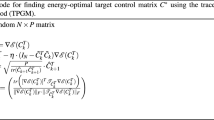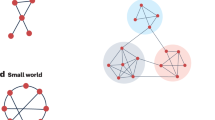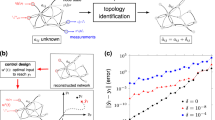Abstract
Recent studies have made important advances in identifying sensor or driver nodes, through which we can observe or control a complex system. But the observational uncertainty induced by measurement noise and the energy required for control continue to be significant challenges in practical applications. Here we show that the variability of control energy and observational uncertainty for different directions of the state space depend strongly on the number of driver nodes. In particular, we find that if all nodes are directly driven, control is energetically feasible, as the maximum energy increases sublinearly with the system size. If, however, we aim to control a system through a single node, control in some directions is energetically prohibitive, increasing exponentially with the system size. For the cases in between, the maximum energy decays exponentially when the number of driver nodes increases. We validate our findings in several model and real networks, arriving at a series of fundamental laws to describe the control energy that together deepen our understanding of complex systems.
This is a preview of subscription content, access via your institution
Access options
Subscribe to this journal
Receive 12 print issues and online access
$209.00 per year
only $17.42 per issue
Buy this article
- Purchase on Springer Link
- Instant access to full article PDF
Prices may be subject to local taxes which are calculated during checkout




Similar content being viewed by others
References
Albert, R. & Barabási, A.-L. Statistical mechanics of complex networks. Rev. Mod. Phys. 74, 47–97 (2002).
Cohen, R. & Havlin, S. Complex Networks: Structure, Robustness and Function (Cambridge Univ. Press, 2010).
Newman, M. E. J. Networks: An Introduction (Oxford Univ. Press, 2010).
Boccaletti, S., Latora, V., Moreno, Y., Chavez, M. & Hwang, D. Complex networks: Structure and dynamics. Phys. Rep. 424, 175–308 (2006).
Barrat, A., Barthelemy, M. & Vespignani, A. Dynamical Processes on Complex Networks (Cambridge Univ. Press, 2008).
Barzel, B. & Barabási, A.-L. Universality in network dynamics. Nature Phys. 9, 673–681 (2013).
Rugh, W. J. Linear System Theory (Prentice-Hall, 1996).
Sontag, E. D. Mathematical Control Theory: Deterministic Finite Dimensional Systems (Springer, 1996).
Slotine, J.-J. & Li, W. Applied Nonlinear Control (Prentice-Hall, 1991).
Liu, Y.-Y., Slotine, J.-J. & Barabási, A.-L. Controllability of complex networks. Nature 473, 167–173 (2011).
Yuan, Z., Zhao, C., Di, Z., Wang, W.-X. & Lai, Y.-C. Exact controllability of complex networks. Nature Commun. 4, 2447 (2013).
Sorrentino, F., di Bernardo, M., Garofalo, F. & Chen, G. Controllability of complex networks via pinning. Phys. Rev. E 75, 046103 (2007).
Yu, W., Chen, G. & Lü, J. On pinning synchronization of complex dynamical networks. Automatica 45, 429–435 (2009).
Rajapakse, I., Groudine, M. & Mesbahi, M. Dynamics and control of state-dependent networks for probing genomic organization. Proc. Natl Acad. Sci. USA 108, 17257–17262 (2011).
Nepusz, T. & Vicsek, T. Controlling edge dynamics in complex networks. Nature Phys. 8, 568–573 (2012).
Yan, G., Ren, J., Lai, Y.-C., Lai, C.-H. & Li, B. Controlling complex networks: How much energy is needed? Phys. Rev. Lett. 108, 218703 (2012).
Sun, J. & Motter, A. E. Controllability transition and nonlocality in network control. Phys. Rev. Lett. 110, 208701 (2013).
Pasqualetti, F., Zampieri, S. & Bullo, F. Controllability metrics, limitations and algorithms for complex networks. IEEE Trans. Control Netw. Syst. 1, 40–52 (2014).
Tang, Y., Gao, H., Zou, W. & Kurths, J. Identifying controlling nodes in neuronal networks in different scales. PLoS ONE 7, e41375 (2012).
Jia, T. et al. Emergence of bimodality in controlling complex networks. Nature Commun. 4, 2002 (2013).
Ruths, J. & Ruths, D. Control profiles of complex networks. Science 343, 1373–1376 (2014).
Menichetti, G., Dall’Asta, L. & Bianconi, G. Network controllability is determined by the density of low in-degree and out-degree nodes. Phys. Rev. Lett. 113, 078701 (2014).
Summers, T. H., Cortesi, F. L. & Lygeros, J. On submodularity and controllability in complex dynamical networks. Preprint at http://arXiv.org/abs/1404.7665v2 (2014)
Tzoumas, V., Rahimian, M. A., Pappas, G. J. & Jadbabaie, A. Minimal actuator placement with optimal control constraints. Preprint at http://arXiv.org/abs/1503.04693 (2015)
Cornelius, S. P., Kath, W. L. & Motter, A. E. Realistic control of network dynamics. Nature Commun. 4, 1942 (2013).
Whalen, A. J., Brennan, S. N., Sauer, T. D. & Schiff, S. J. Observability and controllability of nonlinear networks: The role of symmetry. Phys. Rev. X 5, 011005 (2015).
Menolascina, F. et al. In-vivo real-time control of protein expression from endogenous and synthetic gene networks. PLoS Comput. Biol. 10, e1003625 (2014).
Rahmani, A., Ji, M., Mesbahi, M. & Egerstedt, M. Controllability of multi-agent systems from a graph-theoretic perspective. SIAM J. Control Optim. 48, 162–186 (2009).
Acemoglu, D., Ozdaglar, A. & ParandehGheibi, A. Spread of (mis)information in social networks. Games Econ. Behav. 70, 194–227 (2010).
Liu, Y.-Y., Slotine, J.-J. & Barabási, A.-L. Observability of complex systems. Proc. Natl Acad. Sci. USA 110, 2460–2465 (2013).
Yang, Y., Wang, J. & Motter, A. E. Network observability transitions. Phys. Rev. Lett. 109, 258701 (2012).
Pinto, P. C., Thiran, P. & Vetterli, M. Locating the source of diffusion in large-scale networks. Phys. Rev. Lett. 109, 068702 (2012).
Scheffer, M. et al. Anticipating critical transitions. Science 338, 344–348 (2012).
Friedman, N. Inferring cellular networks using probabilistic graphical models. Science 303, 799–805 (2004).
Almaas, E., Kovács, B., Vicsek, T., Oltvai, Z. N. & Barabási, A.-L. Global organization of metabolic fluxes in the bacterium Escherichia coli. Nature 427, 839–843 (2004).
Castellano, C., Fortunato, S. & Loreto, V. Statistical physics of social dynamics. Rev. Mod. Phys. 81, 591–646 (2009).
May, R. M. Stability and Complexity in Model Ecosystems (Princeton Univ. Press, 1974).
Pecora, L. M. & Carroll, T. L. Master stability functions for synchronized coupled systems. Phys. Rev. Lett. 80, 2109–2112 (1998).
Chung, F., Lu, L. & Vu, V. Spectra of random graphs with given expected degrees. Proc. Natl Acad. Sci. USA 100, 6313–6318 (2003).
Kim, D. & Kahng, B. Spectral densities of scale-free networks. Chaos 17, 026115 (2007).
Cohen, R., Erez, K., ben Avraham, D. & Havlin, S. Resilience of the Internet to random breakdowns. Phys. Rev. Lett. 85, 4626–4628 (2000).
Cowan, N. J., Chastain, E. J., Vilhena, D. A., Freudenberg, J. S. & Bergstrom, C. T. Nodal dynamics, not degree distributions, determine the structural controllability of complex networks. PLoS ONE 7, e38398 (2012).
Antoulas, A. Approximation of Large-Scale Dynamical Systems (SIAM, 2009).
Del Genio, C., Gross, T. & Bassler, K. All scale-free networks are sparse. Phys. Rev. Lett. 107, 178701 (2011).
Kailath, T., Sayed, A. & Hassibi, B. Linear Estimation (Prentice-Hall, 2000).
Watts, D. J. & Strogatz, S. H. Collective dynamics of ‘small-world’ networks. Nature 393, 440–442 (1998).
Newman, M. E. J. Assortative mixing in networks. Phys. Rev. Lett. 89, 208701 (2002).
Girvan, M. & Newman, M. E. J. Community structure in social and biological networks. Proc. Natl Acad. Sci. USA 99, 7821–7826 (2002).
Xulvi-Brunet, R. & Sokolov, I. M. Reshuffling scale-free networks: From random to assortative. Phys. Rev. E 70, 066102 (2004).
Menck, P. J., Heitzig, J., Kurths, J. & Schellnhuber, H. J. How dead ends undermine power grid stability. Nature Commun. 5, 3969 (2014).
Müller, F.-J. & Schuppert, A. Few inputs can reprogram biological networks. Nature 478, E4 (2011).
Todorov, E. & Jordan, M. I. Optimal feedback control as a theory of motor coordination. Nature Neurosci. 5, 1226–1235 (2002).
Coron, J.-M. Control and Nonlinearity (American Mathematical Society, 2009).
Menck, P. J., Heitzig, J., Marwan, N. & Kurths, J. How basin stability complements the linear-stability paradigm. Nature Phys. 9, 89–92 (2013).
Acknowledgements
We thank E. Guney, C. Song, J. Gao, M. T. Angulo, S. P. Cornelius, B. Coutinho and A. Li for discussions. This work was supported by Army Research Laboratories (ARL) Network Science (NS) Collaborative Technology Alliance (CTA) grant ARL NS-CTA W911NF-09-2-0053; DARPA Social Media in Strategic Communications project under agreement number W911NF-12-C-002; the John Templeton Foundation: Mathematical and Physical Sciences grant number PFI-777; European Commission grant numbers FP7 317532 (MULTIPLEX) and 641191 (CIMPLEX).
Author information
Authors and Affiliations
Contributions
All authors designed and performed the research. G.Y. and G.T. carried out the numerical calculations. G.Y. did the analytical calculations and analysed the empirical data. G.T., B.B., J.-J.S., Y.-Y.L. and A.-L.B. analysed the results. G.Y. and A.-L.B. were the main writers of the manuscript. G.T., B.B. and Y.-Y.L. edited the manuscript. G.Y. and G.T. contributed equally to this work.
Corresponding author
Ethics declarations
Competing interests
The authors declare no competing financial interests.
Supplementary information
Supplementary information
Supplementary information (PDF 1507 kb)
Rights and permissions
About this article
Cite this article
Yan, G., Tsekenis, G., Barzel, B. et al. Spectrum of controlling and observing complex networks. Nature Phys 11, 779–786 (2015). https://doi.org/10.1038/nphys3422
Received:
Accepted:
Published:
Issue Date:
DOI: https://doi.org/10.1038/nphys3422
This article is cited by
-
Input node placement restricting the longest control chain in controllability of complex networks
Scientific Reports (2023)
-
Structural controllability of general edge dynamics in complex network
Scientific Reports (2023)
-
Tank-dependence of the functionality and network differentiation of activated sludge community in a full-scale anaerobic/anoxic/aerobic municipal sewage treatment plant
Frontiers of Environmental Science & Engineering (2023)
-
The inherent uncertainty of temporal networks is a true challenge for control
Scientific Reports (2021)
-
Heuristic assessment of choices for risk network control
Scientific Reports (2021)



